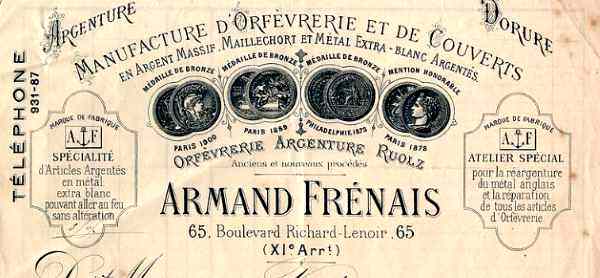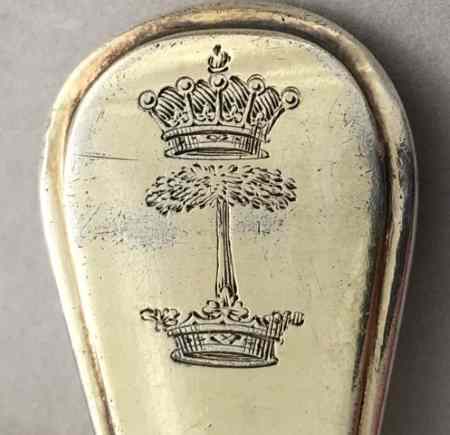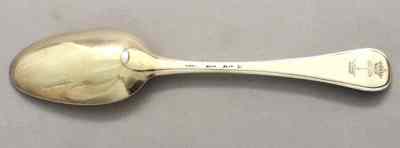YOUR GUIDE TO APRIL NEWSLETTER:
articles
new members
members' window
mail to ASCAS
replies to questions
a page per month
a silversmith per month
a word per month
a book on my shelf
a crest per month
contributors to this Newsletter
search engine
disclaimer and privacy policy
A new article for ASCAS website
Maurice Meslans presents:
What Hath Kirstein Wrought?


The first person of that name to work as a silversmith in Strasbourg was Joachim Friederich Kirstein I (1701-1770, master in 1729), who was son of a "forestier" named Kirstenstein in Beelitz in Prussia. The Kirsteins most connected with these plaques are Jacques Frédéric Kirstein (1765-1838, established in 1795), and his son, Joachim Frédéric Kirstein II (1805-1860) who worked with him and followed him in the business.
Hans Haug usually refers to them as "bas relief repoussé et ciselé" (chiseled). In "Deux Siècle d'orfèvrerie à Strasbourg" they are usually referred to as "argent fondu" (cast silver). Interesting enough J. F. Kirstein gave us his own version in "Bulletin De La Société D'encouragement Pour L'Industrie Nationale" of 1811. In it he describes a process which seems to be standard repoussé work with the exception that some pieces are made to stand out by separating at least part of them from the background. Thus a tree branch would still be connected to the trunk but would otherwise be floating above the rest of the work. This would obviously be a very labor intensive process. The other thing to note in the article was that while six of the works were either rural or hunting scenes, for which he is well known, the other four were political (Napoleon, Frederich the Great) or battle scenes. Below you see an example found in the Strasbourg catalogue....
click here

New members
Welcome to new ASCAS members:
Eleanor Bennett & Danielle Boyd - England UK
Caron Hassen - USA
Brenda Levin-Ehrlich - The Netherlands
Francesco Rossi - Italy
Andrew Scott - England UK
Mail to ASCAS:
e-mail
silverassociation@yahoo.it
Daniel Thuriaux writes:
...Please, could you help me identifying the date for my silver tableware?
Thanks in advance,
Daniel Thuriaux
About dating of silverplate read my webpage at http://www.silvercollection.it/dictionarydecryptingsilverplatemarks.html
I can add this further information:
77/78 Oxford Street shop was opened in 1866 and closed c. 1880.
71/72 Cornhill was opened in 1866 and closed c. 1871.
Giorgio Busetto
Isabel Smith:
...A silver bowl with cover in the rococo style, well-made and rather beautiful. Weight over 700g. Height 20cm. In my family since 1902 and said to have been a wedding present to my grandparents from a rich American, one Philo Mills, then living in Nottingham where he owned a lace factory?
The bowl itself is moulded from 3 pieces (lines visible inside, external heads and feet attached at junctions). Lid's rim sits inside bowl. Interior of lid not visible because a sheet of polished silver covers opening.
The only full set of marks is on the rim of the cover (maker, lion, Victoria's head, London date letter 1842, leopard) but are partially "sliced off". The silver looks somehow different from the cover itself. There is a "ridge" above the marks (visible in the photo) and a small, round rough area on the inner surface of the rim. The monarch's head, lion and makers mark appears on the base of the bowl (see photo) and also inside the cherub's wing. The maker's marks are a close match to those of John Samuel Hunt whose style is echoed in the piece.
I am a novice engaged in cataloguing the family silver and am concluding that the marks are fake, those on the rim being taken from another item. If so why would a 19thcentury silversmith, who could produce an item like this, do it?
Best regards
Isabel Smith
William Isbister writes:
Dear Giorgio,
Do you think any member would know what this is?
The apical cone has a central circular indentation and cruciate grooves and is spring loaded. The object is only 3.5 cm. long.
It is marked 'patent', was assayed in Birmingham in 1902 and seems to have the sponsor's mark of WJH - William J Holmes.
William Isbister
Frank W Wilson writes:
Dear Giorgio,
I am taking the liberty of sending you some photos of a mystery box, which has remained a mystery in my collection for some time.
I bought a few years ago from an online auction, assuming it to have an ecclesiastic connection, perhaps for a priest to place a few portable Hosts for itinerant pastoral purposes?
I made this connection due to its flat design and a Bishop's mitre on the lid. Nothing else guided my thinking and as I was collecting mustards etc at the time it remained a mystery box for later investigation. I have realised that I know nothing about this rather nicely made flat box?
Would you be able to shed some light please. The makers mark G.W with a London panther's head is all I have. It is marked capital N in a shield.
The box has a Sterling Mark, date letter N and a young Victoria head, it measures 83x45x10mm and has a nice decoration, with I think a gilded interior.
I would be so grateful for any light you can shine on my search.
Frank W Wilson
I don't believe that your box was a portable host container (usually they are of circular shape).
In my opinion: not a pix, not a cigarette case, not a vesta case, not a snuff box. Possibly a calling card holder.
The maker is George Wilkinson of Thomas Wilkinson & Sons.
Giorgio Busetto
Andrea Bonandrom writes:
...Would you be able to tell me who is the maker of these spoons?
Thank you in advance,
Andrea Bonandrom
Laura Cahill writes:
...Do you have any idea what the symbol after the S means?
I've searched everywhere and cannot find anything about it.
Thank you,
Laura Cahill
Andrew J. Brasch writes:
...Do you know who is the "FM" maker of this Austrian coffee pot date 1804?
Thank you,
Andrew J. Brasch
In my opinion the mark is F.W not FM.
If so, a Viennese maker active in 1804 is Franz Joseph Seraphin Wurth, active 1797-1831
Giorgio Busetto
Bill Kime writes
Many thanks for your latest interesting newsletter, in which Judith asks about a mystery object made by Gorham. The object I believe is a luna, the removable part of a monstrance or ostensorium containing the Blessed Sacrament.
Bill Kime
Janjaap Luijt weites
The object made by Gorham (question by Judith) is a lunula or custode to house a host in a monstrance.
Janjaap Luijt
"A PAGE per MONTH"
In this column we presents a page obtained from makers'
brochures, books, auction catalogs, advertising or whatever
other printed paper, related to silver, that may be of interest
for ASCAS members.
The images will be published at a "low resolution" level and for
private and personal use only.
This column is published under the kind permission of Giorgio
Busetto's website

ARMAND FRÉNAIS
MANUFACTURE D'ORFÈVRERIE ET DE COUVERTS

Armand Frenais was a renowned French silversmith and electroplater.
The firm was active in Paris at 65 Boulevard Richard Lenoir between 1877 and 1927.


"A WORD per MONTH"
In this column we
present an abstract from a page of the "What is? Silver Dictionary"
courtesy of


FLATWARE PATTERNS
HOLMES & EDWARDS

The Holmes & Edwards Silver Co began its activity in 1882 succeeding to Rogers & Brittin.
The initial business was the production of low priced plated flatware using its own blanks or simply plating blanks of other manufacturers.
The qualitative leap in Holmes & Edwards production occurred with the acquisition of the invention patents obtained by William A. Warner of Syracuse for a technique of inlaying blocks of sterling silver at the wear points on the back of spoons and forks prior to plating them.
In this page is illustrated a selection of flatware patterns manufactured by Holmes & Edwards....
MORE...
"A SILVERSMITH per MONTH"
SHREVE, CRUMP & LOW CO. INC.
According to tradition, the founder of the business was John McFarlane proprietor in 1796 of a watchmaker's shop in Salem.
The business was continued by Jabez Baldwin, who in the early 1800s moved to Boston establishing a business under the title of Baldwin & Jones.
In 1822, two apprentices of Jabez Baldwin in Salem, John J. Low and Edward Putnam, established the firm Putnam & Low. Some years later the partnership was dissolved and in 1839 John J. Low, his brother Francis Low and George B, Jones established a new partnership as Jones, Low and Ball....
MORE...
"A CREST per MONTH"
FAMILY CRESTS: LIST OF NAMES
ILLUSTRATED DIRECTORY OF FAMILY CRESTS
ASHBURNHAM
The crest is described as an ash tree coming out of a ducal crown. The crown above is an earl's crown.
The tablespoon is a rare pattern called Thread, Shell & Drop. It was originally primarily made by Isaac Callard a Huguenot silversmith in London. It is probably c. 1750, or a bit earlier. While the marks are mostly illegible the J of one points to Isaac's second mark. The others are probably either the same mark badly distorted, or those of his son Paul.
There was a number of Earls of Ashburnham. John Ashburnham became the 2nd Earl of Ashburnham in 1748. It seems very tempting to say that then or soon after he bought this spoon.
(Information courtesy of Maurice Meslans)
"A YEAR per MONTH"
FROM SHEFFIELD ASSAY OFFICE REGISTER
- 1775 -
DISCLAIMER AND PRIVACY POLICY
ASCAS is a community of people having a common
interest in antique silver.
It is a non-profit association without commercial links.
Membership is open to whomever has a true interest in
this subject matter.
ASCAS has no real property and no fees are requested nor
accepted from members.
ASCAS keeps in touch with its members only through
periodical newsletters, e-mails and web-site updating
and ignores and is not responsible for any other
activity pursued by its members.
Likewise, ASCAS is not responsible for opinions,
evaluation and images displayed, and in any form
published or supplied for publication, by its members
who, in any case, maintain the property of their works
and assure the respect of national and international
legislation about Intellectual Property.
ASCAS does not have the full addresses of its members (only
town, country and e-mail address are requested for
membership).
ASCAS handles and protects with care its members' e-mail
addresses, will not disclose the addresses to third
parties, will use this information only to reply to
requests received from members and for communications
strictly related to its activity.
These rules are expressly accepted by submitting the
membership request.
|
|







































